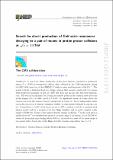Search for direct production of GeV-scale resonances decaying to a pair of muons in proton-proton collisions at √s = 13 TeV
Author(s)
Hayrapetyan, A.; Tumasyan, A.; Adam, W.; Andrejkovic, J. W.; Bergauer, T.; Chatterjee, S.; Damanakis, K.; Dragicevic, M.; Escalante Del Valle, A.; Hussain, P. S.; Jeitler, M.; Krammer, N.; Liko, D.; Mikulec, I.; Schieck, J.; Schöfbeck, R.; Schwarz, D.; Sonawane, M.; ... Show more Show less
Download13130_2023_Article_22380.pdf (1.192Mb)
Publisher with Creative Commons License
Publisher with Creative Commons License
Creative Commons Attribution
Terms of use
Metadata
Show full item recordAbstract
A search for direct production of low-mass dimuon resonances is performed using
s
$$ \sqrt{s} $$
= 13 TeV proton-proton collision data collected by the CMS experiment during the 2017–2018 operation of the CERN LHC with an integrated luminosity of 96.6 fb−1. The search exploits a dedicated high-rate trigger stream that records events with two muons with transverse momenta as low as 3 GeV but does not include the full event information. The search is performed by looking for narrow peaks in the dimuon mass spectrum in the ranges of 1.1–2.6 GeV and 4.2–7.9 GeV. No significant excess of events above the expectation from the standard model background is observed. Model-independent limits on production rates of dimuon resonances within the experimental fiducial acceptance are set. Competitive or world’s best limits are set at 90% confidence level for a minimal dark photon model and for a scenario with two Higgs doublets and an extra complex scalar singlet (2HDM+S). Values of the squared kinetic mixing coefficient ε2 in the dark photon model above 10−6 are excluded over most of the mass range of the search. In the 2HDM+S, values of the mixing angle sin(θH) above 0.08 are excluded over most of the mass range of the search with a fixed ratio of the Higgs doublets vacuum expectation tan β = 0.5.
Date issued
2023-12-12Department
Massachusetts Institute of Technology. Department of PhysicsPublisher
Springer Berlin Heidelberg
Citation
Journal of High Energy Physics. 2023 Dec 12;2023(12):70
Version: Final published version